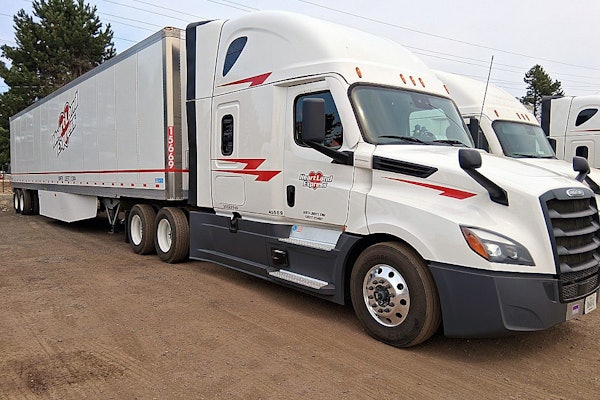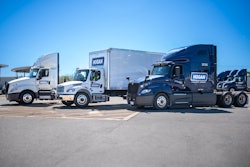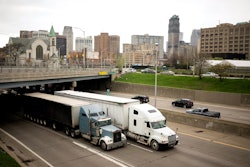The life of a refuse truck is nonstop abuse, with harsh work cycles, constant demands for increased efficiency and no compromises on reliability and durability. Mack Trucks says its new TerraPro Series delivers everything needed to handle that, plus a new driver environment to improve comfort and boost productivity.
The TerraPro Series includes the TerraPro Low Entry and the TerraPro Cabover. The construction industry version of the TerraPro Cabover was introduced at the World of Concrete in January. Refuse customers will be able to see the complete TerraPro Series dedicated for tough refuse applications at Waste Expo in Atlanta on Tuesday-Thursday, May 8-10.
“Mack designed the TerraPro Series models from the inside out, based on many decades of experience in the refuse business,” says Steve Ginter, vocational products manager of Lehigh Valley, Pa.-based Mack. “The TerraPro Series takes everything we learned with the Mack MR and LE models, and gives customers the most versatile and comfortable trucks Mack has ever built for the refuse industry.”
Mack says the TerraPro Low Entry comes with many features designed for the specific needs of the refuse industry:
“Mack’s refuse customers are in a tough, competitive business that demands maximum efficiency,” says Tom Kelly, Mack vice president of marketing. “Our commitment to customer focus means truly understanding our customers’ operations. Drivers play a huge role in refuse applications, and our new TerraPro Low Entry model allows them to achieve full productivity.”
Also critical to refuse truck productivity is a well-designed work brake — and the Mack Work Brake System is designed with fail-safe features. Moving the brake’s hand lever activates the brake and engages the service brakes, thereby holding the truck’s position during refuse collection; releasing the brake and engaging the transmission also requires only one movement. This feature is designed to save time for drivers in high-cycle operations and reduce wear and tear on brake components.
Mack engineers and designers went to great lengths to make the TerraPro Low Entry and its sibling, the TerraPro Cabover, a comfortable and productive work environment for drivers. Interior features, according to the company, include ergonomic seats; easy-to-read gauges and easy-to-reach switches; provisions for mounting camera systems; steering column positioned for ample belly room; efficient, effective HVAC climate control system; easy-to-reach parking brake; cab lighting controls reachable from the ground; plenty of storage; and a cup holder designed for easy use in a work truck.
Mack says the TerraPro Cabover also has an integrated armrest, ideal for joystick operation; courtesy map light; accelerator and brake pedals suspended above the cab floor and mounted in-line to reduce driver effort (the suspended pedals also make the floor easier to clean); and a smooth quiet ride, thanks to the design of its engine mounts, cab bushings and rubber isolators, and electronically controlled fan — all of which minimize noise and vibration on the job.
The interior of the TerraPro Series is designed to be as efficient and productive as it is comfortable, according to the company: Its low-profile electronic dash enhances visibility while at the same time incorporating comprehensive driver information displays. The instrument cluster features 25 indicator lights, while the dash also contains an automatic transmission temperature gauge; electronic gauges improve accuracy and reliability while eliminating oil lines and most air lines from the gauge cluster. A new standard engine hour meter that features a wake-up display when the ignition is off also is included. A battery backup is added to protect vital information stored in the engine control systems.
The TerraPro Series features the next generation of Mack’s Vehicle Management and Control System — V-MAC IV — which the company says allows customers to better control costs and closely monitor truck and engine performance. The V-MAC IV system offers more than 100 proven programmable features, and adds a host of new items, including road speed tamper detection, integrated starter protection and programmable daytime running light override. V-MAC IV electronics include DataMax, advanced software designed to capture information such as vehicle trip histories, duty cycle information and scheduled maintenance intervals.
Both customers and bodybuilders will appreciate the in-cab Control Link and back-of-cab Body Link II electrical interface systems in the new TerraPro models. These are designed to provide required quick-connections to the bodybuilder’s control unit, as well as pass-through harnesses and connectors from the controller to the body — meeting the needs of any application in the refuse industry. The TerraPro Cabover model features pneumatic lines for joystick mounting on the integrated armrest.
Offered with the Mack camelback rear suspension, the TerraPro Cabover also can be spec’d with the Mack M-Ride six-rod suspension, designed to allow up to 17-inch articulation for maneuverability in landfills and on jobsites. The TerraPro Series is available in both 6×4 and 4×2 axle configurations.
The TerraPro Low Entry comes standard with the Environmental Protection Agency’s 2007-certified 11-liter Mack MP7 engine, in two ratings: the MP7-325M Maxidyne model with 325 hp and 1,200 lb-ft of torque; and the MP7-345C MaxiCruise version with 345 hp and 1,360 lb-ft of torque. The TerraPro Cabover is standard with the Mack MP7-325M and has optional Mack engines up to 405 hp. Mack says the MP7 has superior low-end torque and power, and features single overhead cams, electronically controlled ultra-high-pressure fuel injection, one-piece steel pistons, and robust bearings and cylinder heads.
Refuse vehicles frequently work in densely populated areas, with intense public demands for clean operations. Mack says the TerraPro Low Entry meets these demands with an application-specific diesel particulate filter — the Mack Back-of-Cab Non-Catalyzed DPF — that reduces particulate matter emissions by more than 90 percent over the previous generation of engines.







